Effects of Hydrotherapy, Community-based Exercise, Aqua-based Exercise, and Physical Activity on Older Adults
VerifiedAdded on 2023/06/13
|5
|1436
|126
AI Summary
This research paper discusses the effects of hydrotherapy, community-based exercise, aqua-based exercise, and physical activity on older adults. It covers the benefits, motives, and barriers to these exercises, as well as the demographic and health implications for Australia and New Zealand.
Contribute Materials
Your contribution can guide someone’s learning journey. Share your
documents today.
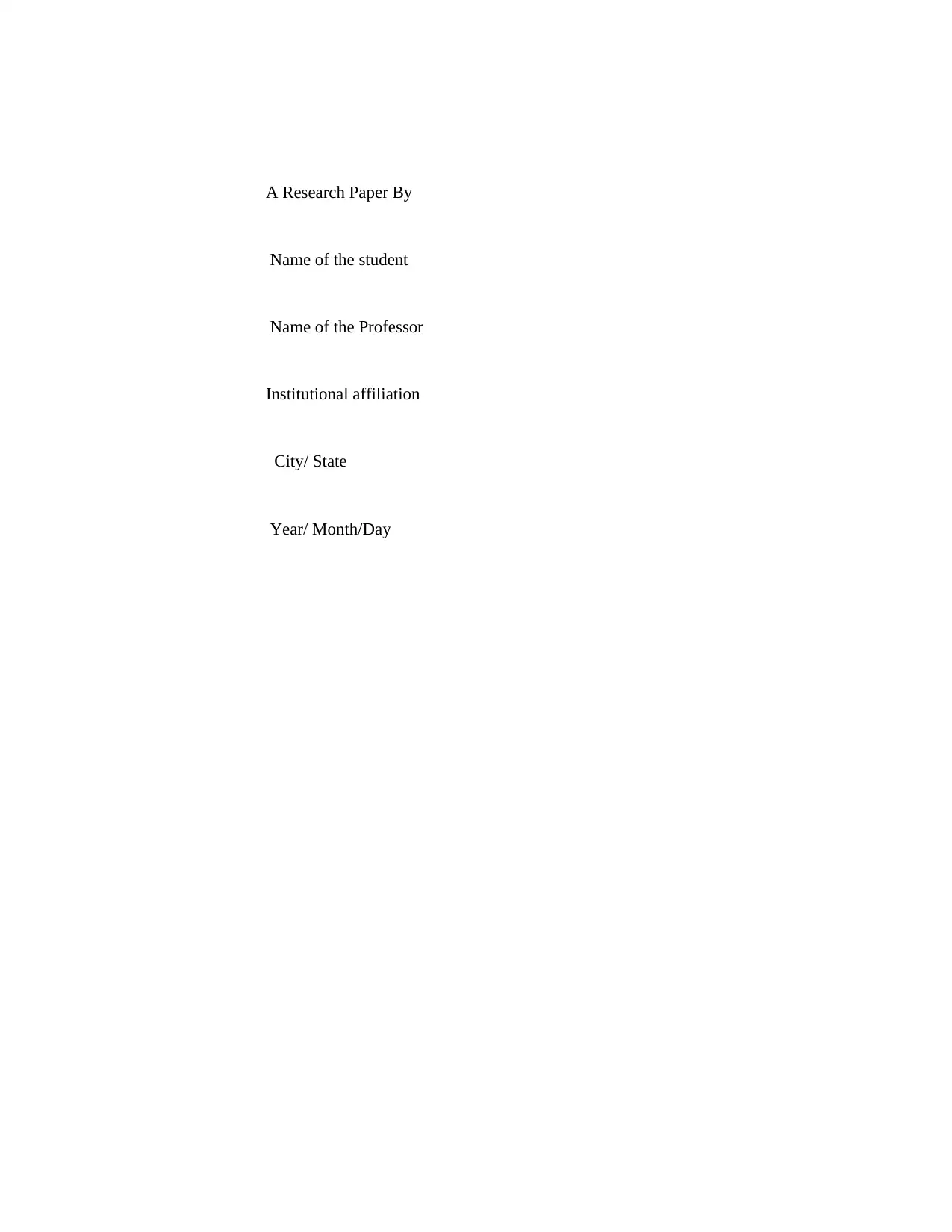
A Research Paper By
Name of the student
Name of the Professor
Institutional affiliation
City/ State
Year/ Month/Day
Name of the student
Name of the Professor
Institutional affiliation
City/ State
Year/ Month/Day
Secure Best Marks with AI Grader
Need help grading? Try our AI Grader for instant feedback on your assignments.
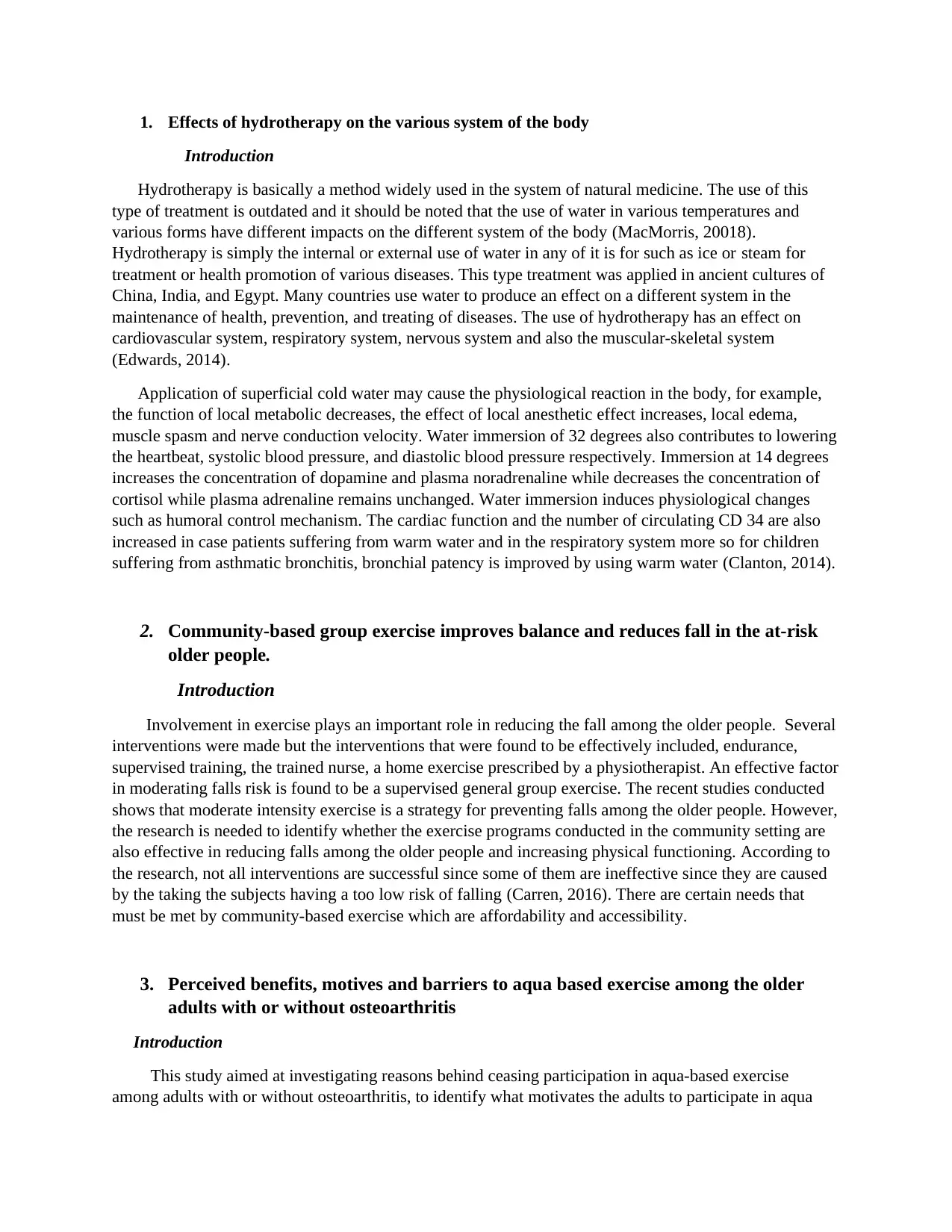
1. Effects of hydrotherapy on the various system of the body
Introduction
Hydrotherapy is basically a method widely used in the system of natural medicine. The use of this
type of treatment is outdated and it should be noted that the use of water in various temperatures and
various forms have different impacts on the different system of the body (MacMorris, 20018).
Hydrotherapy is simply the internal or external use of water in any of it is for such as ice or steam for
treatment or health promotion of various diseases. This type treatment was applied in ancient cultures of
China, India, and Egypt. Many countries use water to produce an effect on a different system in the
maintenance of health, prevention, and treating of diseases. The use of hydrotherapy has an effect on
cardiovascular system, respiratory system, nervous system and also the muscular-skeletal system
(Edwards, 2014).
Application of superficial cold water may cause the physiological reaction in the body, for example,
the function of local metabolic decreases, the effect of local anesthetic effect increases, local edema,
muscle spasm and nerve conduction velocity. Water immersion of 32 degrees also contributes to lowering
the heartbeat, systolic blood pressure, and diastolic blood pressure respectively. Immersion at 14 degrees
increases the concentration of dopamine and plasma noradrenaline while decreases the concentration of
cortisol while plasma adrenaline remains unchanged. Water immersion induces physiological changes
such as humoral control mechanism. The cardiac function and the number of circulating CD 34 are also
increased in case patients suffering from warm water and in the respiratory system more so for children
suffering from asthmatic bronchitis, bronchial patency is improved by using warm water (Clanton, 2014).
2. Community-based group exercise improves balance and reduces fall in the at-risk
older people.
Introduction
Involvement in exercise plays an important role in reducing the fall among the older people. Several
interventions were made but the interventions that were found to be effectively included, endurance,
supervised training, the trained nurse, a home exercise prescribed by a physiotherapist. An effective factor
in moderating falls risk is found to be a supervised general group exercise. The recent studies conducted
shows that moderate intensity exercise is a strategy for preventing falls among the older people. However,
the research is needed to identify whether the exercise programs conducted in the community setting are
also effective in reducing falls among the older people and increasing physical functioning. According to
the research, not all interventions are successful since some of them are ineffective since they are caused
by the taking the subjects having a too low risk of falling (Carren, 2016). There are certain needs that
must be met by community-based exercise which are affordability and accessibility.
3. Perceived benefits, motives and barriers to aqua based exercise among the older
adults with or without osteoarthritis
Introduction
This study aimed at investigating reasons behind ceasing participation in aqua-based exercise
among adults with or without osteoarthritis, to identify what motivates the adults to participate in aqua
Introduction
Hydrotherapy is basically a method widely used in the system of natural medicine. The use of this
type of treatment is outdated and it should be noted that the use of water in various temperatures and
various forms have different impacts on the different system of the body (MacMorris, 20018).
Hydrotherapy is simply the internal or external use of water in any of it is for such as ice or steam for
treatment or health promotion of various diseases. This type treatment was applied in ancient cultures of
China, India, and Egypt. Many countries use water to produce an effect on a different system in the
maintenance of health, prevention, and treating of diseases. The use of hydrotherapy has an effect on
cardiovascular system, respiratory system, nervous system and also the muscular-skeletal system
(Edwards, 2014).
Application of superficial cold water may cause the physiological reaction in the body, for example,
the function of local metabolic decreases, the effect of local anesthetic effect increases, local edema,
muscle spasm and nerve conduction velocity. Water immersion of 32 degrees also contributes to lowering
the heartbeat, systolic blood pressure, and diastolic blood pressure respectively. Immersion at 14 degrees
increases the concentration of dopamine and plasma noradrenaline while decreases the concentration of
cortisol while plasma adrenaline remains unchanged. Water immersion induces physiological changes
such as humoral control mechanism. The cardiac function and the number of circulating CD 34 are also
increased in case patients suffering from warm water and in the respiratory system more so for children
suffering from asthmatic bronchitis, bronchial patency is improved by using warm water (Clanton, 2014).
2. Community-based group exercise improves balance and reduces fall in the at-risk
older people.
Introduction
Involvement in exercise plays an important role in reducing the fall among the older people. Several
interventions were made but the interventions that were found to be effectively included, endurance,
supervised training, the trained nurse, a home exercise prescribed by a physiotherapist. An effective factor
in moderating falls risk is found to be a supervised general group exercise. The recent studies conducted
shows that moderate intensity exercise is a strategy for preventing falls among the older people. However,
the research is needed to identify whether the exercise programs conducted in the community setting are
also effective in reducing falls among the older people and increasing physical functioning. According to
the research, not all interventions are successful since some of them are ineffective since they are caused
by the taking the subjects having a too low risk of falling (Carren, 2016). There are certain needs that
must be met by community-based exercise which are affordability and accessibility.
3. Perceived benefits, motives and barriers to aqua based exercise among the older
adults with or without osteoarthritis
Introduction
This study aimed at investigating reasons behind ceasing participation in aqua-based exercise
among adults with or without osteoarthritis, to identify what motivates the adults to participate in aqua
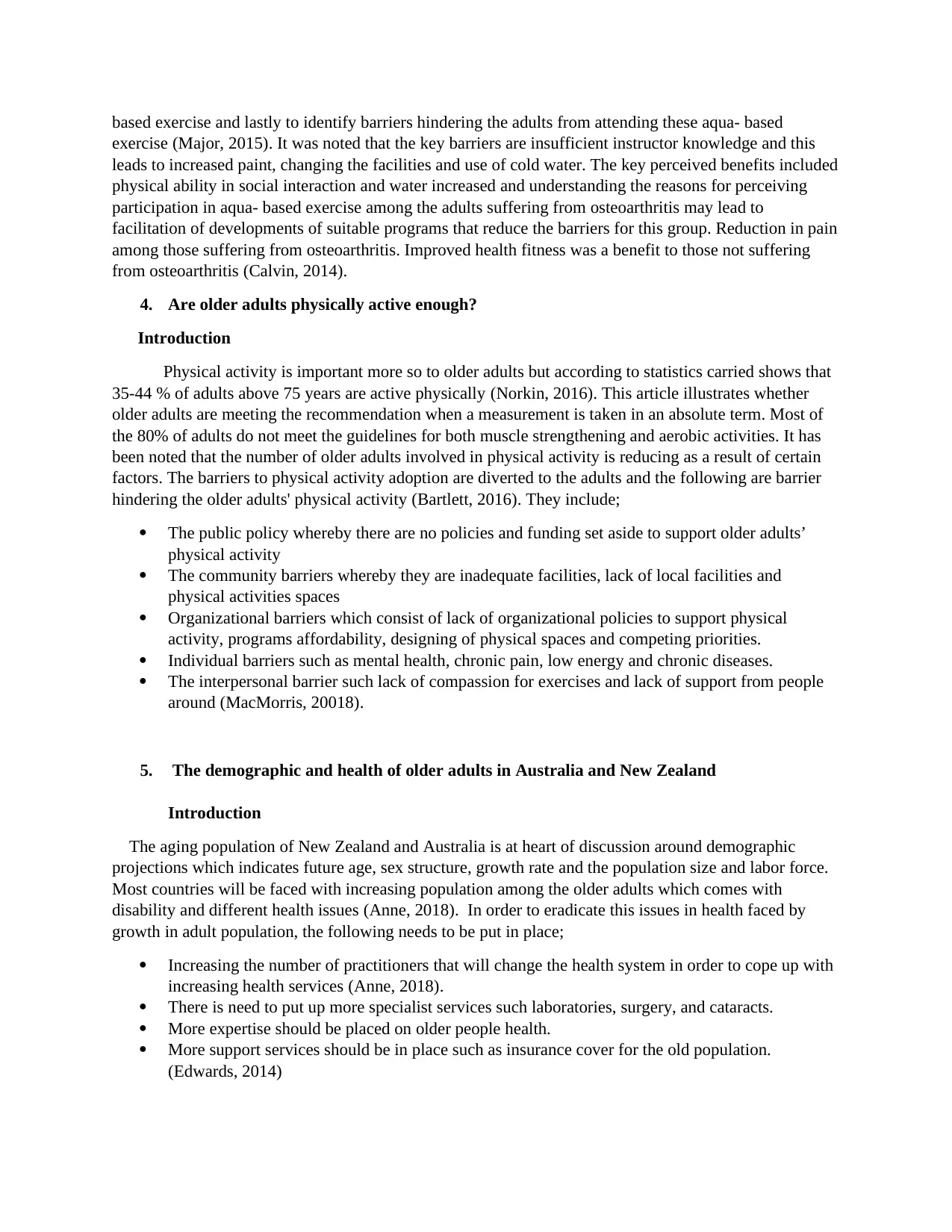
based exercise and lastly to identify barriers hindering the adults from attending these aqua- based
exercise (Major, 2015). It was noted that the key barriers are insufficient instructor knowledge and this
leads to increased paint, changing the facilities and use of cold water. The key perceived benefits included
physical ability in social interaction and water increased and understanding the reasons for perceiving
participation in aqua- based exercise among the adults suffering from osteoarthritis may lead to
facilitation of developments of suitable programs that reduce the barriers for this group. Reduction in pain
among those suffering from osteoarthritis. Improved health fitness was a benefit to those not suffering
from osteoarthritis (Calvin, 2014).
4. Are older adults physically active enough?
Introduction
Physical activity is important more so to older adults but according to statistics carried shows that
35-44 % of adults above 75 years are active physically (Norkin, 2016). This article illustrates whether
older adults are meeting the recommendation when a measurement is taken in an absolute term. Most of
the 80% of adults do not meet the guidelines for both muscle strengthening and aerobic activities. It has
been noted that the number of older adults involved in physical activity is reducing as a result of certain
factors. The barriers to physical activity adoption are diverted to the adults and the following are barrier
hindering the older adults' physical activity (Bartlett, 2016). They include;
The public policy whereby there are no policies and funding set aside to support older adults’
physical activity
The community barriers whereby they are inadequate facilities, lack of local facilities and
physical activities spaces
Organizational barriers which consist of lack of organizational policies to support physical
activity, programs affordability, designing of physical spaces and competing priorities.
Individual barriers such as mental health, chronic pain, low energy and chronic diseases.
The interpersonal barrier such lack of compassion for exercises and lack of support from people
around (MacMorris, 20018).
5. The demographic and health of older adults in Australia and New Zealand
Introduction
The aging population of New Zealand and Australia is at heart of discussion around demographic
projections which indicates future age, sex structure, growth rate and the population size and labor force.
Most countries will be faced with increasing population among the older adults which comes with
disability and different health issues (Anne, 2018). In order to eradicate this issues in health faced by
growth in adult population, the following needs to be put in place;
Increasing the number of practitioners that will change the health system in order to cope up with
increasing health services (Anne, 2018).
There is need to put up more specialist services such laboratories, surgery, and cataracts.
More expertise should be placed on older people health.
More support services should be in place such as insurance cover for the old population.
(Edwards, 2014)
exercise (Major, 2015). It was noted that the key barriers are insufficient instructor knowledge and this
leads to increased paint, changing the facilities and use of cold water. The key perceived benefits included
physical ability in social interaction and water increased and understanding the reasons for perceiving
participation in aqua- based exercise among the adults suffering from osteoarthritis may lead to
facilitation of developments of suitable programs that reduce the barriers for this group. Reduction in pain
among those suffering from osteoarthritis. Improved health fitness was a benefit to those not suffering
from osteoarthritis (Calvin, 2014).
4. Are older adults physically active enough?
Introduction
Physical activity is important more so to older adults but according to statistics carried shows that
35-44 % of adults above 75 years are active physically (Norkin, 2016). This article illustrates whether
older adults are meeting the recommendation when a measurement is taken in an absolute term. Most of
the 80% of adults do not meet the guidelines for both muscle strengthening and aerobic activities. It has
been noted that the number of older adults involved in physical activity is reducing as a result of certain
factors. The barriers to physical activity adoption are diverted to the adults and the following are barrier
hindering the older adults' physical activity (Bartlett, 2016). They include;
The public policy whereby there are no policies and funding set aside to support older adults’
physical activity
The community barriers whereby they are inadequate facilities, lack of local facilities and
physical activities spaces
Organizational barriers which consist of lack of organizational policies to support physical
activity, programs affordability, designing of physical spaces and competing priorities.
Individual barriers such as mental health, chronic pain, low energy and chronic diseases.
The interpersonal barrier such lack of compassion for exercises and lack of support from people
around (MacMorris, 20018).
5. The demographic and health of older adults in Australia and New Zealand
Introduction
The aging population of New Zealand and Australia is at heart of discussion around demographic
projections which indicates future age, sex structure, growth rate and the population size and labor force.
Most countries will be faced with increasing population among the older adults which comes with
disability and different health issues (Anne, 2018). In order to eradicate this issues in health faced by
growth in adult population, the following needs to be put in place;
Increasing the number of practitioners that will change the health system in order to cope up with
increasing health services (Anne, 2018).
There is need to put up more specialist services such laboratories, surgery, and cataracts.
More expertise should be placed on older people health.
More support services should be in place such as insurance cover for the old population.
(Edwards, 2014)
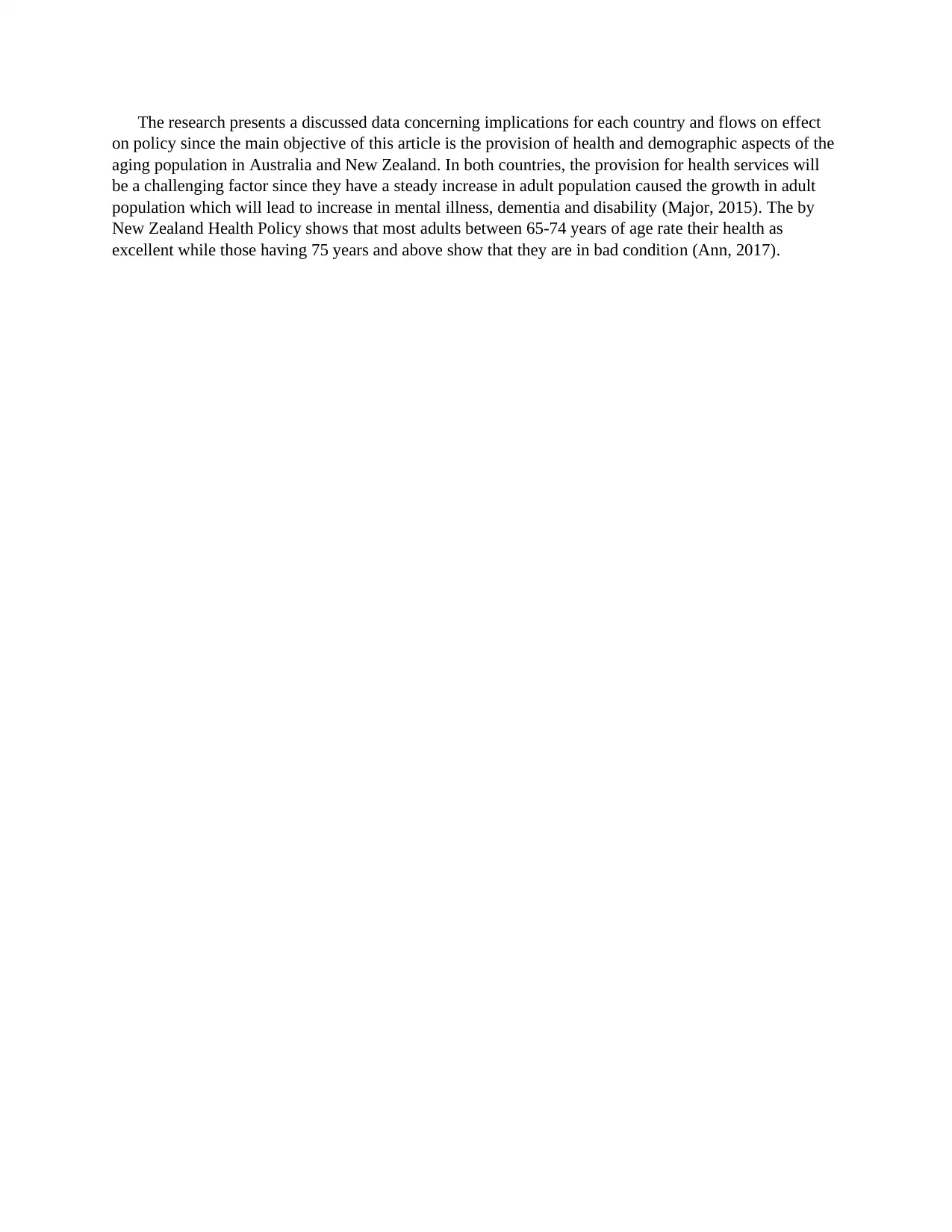
The research presents a discussed data concerning implications for each country and flows on effect
on policy since the main objective of this article is the provision of health and demographic aspects of the
aging population in Australia and New Zealand. In both countries, the provision for health services will
be a challenging factor since they have a steady increase in adult population caused the growth in adult
population which will lead to increase in mental illness, dementia and disability (Major, 2015). The by
New Zealand Health Policy shows that most adults between 65-74 years of age rate their health as
excellent while those having 75 years and above show that they are in bad condition (Ann, 2017).
on policy since the main objective of this article is the provision of health and demographic aspects of the
aging population in Australia and New Zealand. In both countries, the provision for health services will
be a challenging factor since they have a steady increase in adult population caused the growth in adult
population which will lead to increase in mental illness, dementia and disability (Major, 2015). The by
New Zealand Health Policy shows that most adults between 65-74 years of age rate their health as
excellent while those having 75 years and above show that they are in bad condition (Ann, 2017).
Secure Best Marks with AI Grader
Need help grading? Try our AI Grader for instant feedback on your assignments.
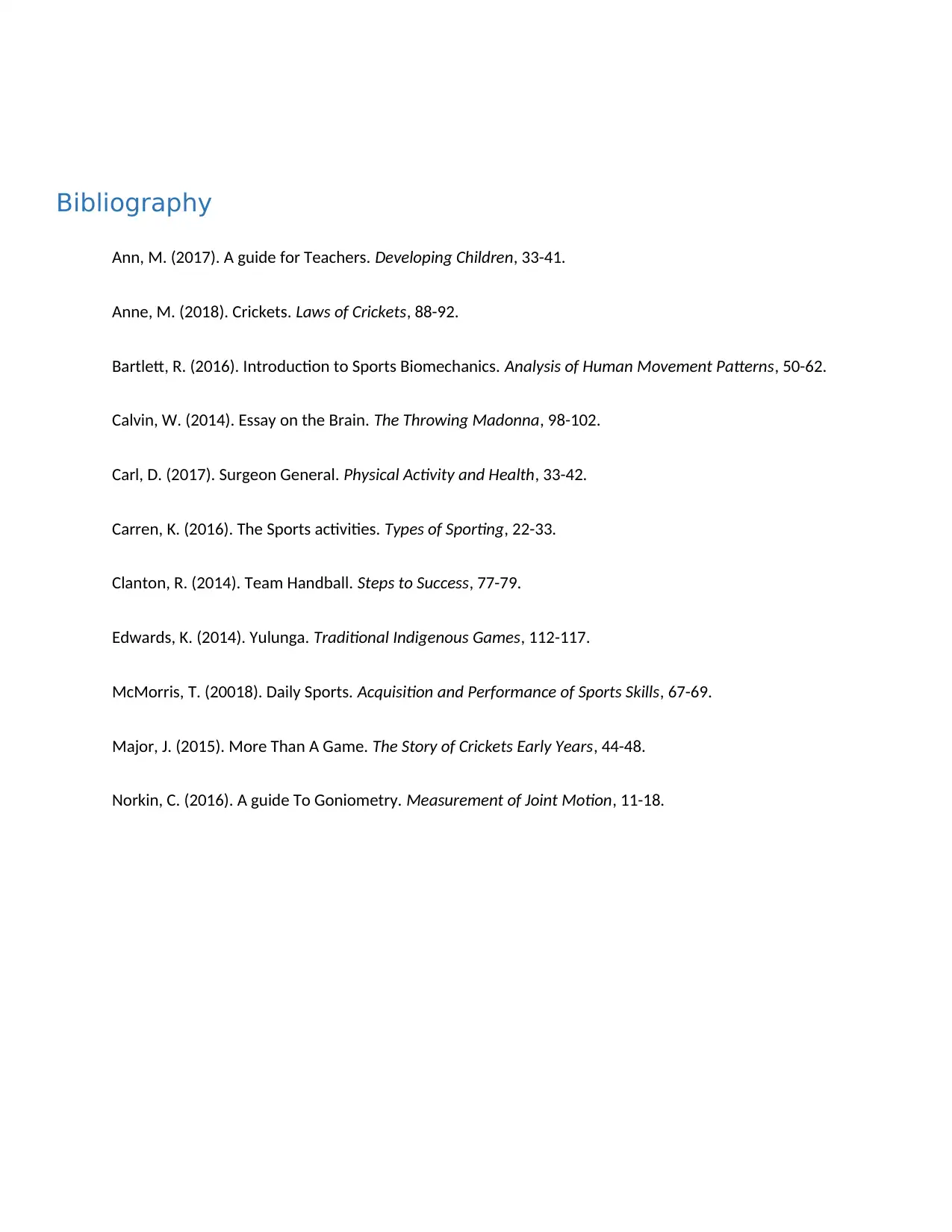
Bibliography
Ann, M. (2017). A guide for Teachers. Developing Children, 33-41.
Anne, M. (2018). Crickets. Laws of Crickets, 88-92.
Bartlett, R. (2016). Introduction to Sports Biomechanics. Analysis of Human Movement Patterns, 50-62.
Calvin, W. (2014). Essay on the Brain. The Throwing Madonna, 98-102.
Carl, D. (2017). Surgeon General. Physical Activity and Health, 33-42.
Carren, K. (2016). The Sports activities. Types of Sporting, 22-33.
Clanton, R. (2014). Team Handball. Steps to Success, 77-79.
Edwards, K. (2014). Yulunga. Traditional Indigenous Games, 112-117.
McMorris, T. (20018). Daily Sports. Acquisition and Performance of Sports Skills, 67-69.
Major, J. (2015). More Than A Game. The Story of Crickets Early Years, 44-48.
Norkin, C. (2016). A guide To Goniometry. Measurement of Joint Motion, 11-18.
Ann, M. (2017). A guide for Teachers. Developing Children, 33-41.
Anne, M. (2018). Crickets. Laws of Crickets, 88-92.
Bartlett, R. (2016). Introduction to Sports Biomechanics. Analysis of Human Movement Patterns, 50-62.
Calvin, W. (2014). Essay on the Brain. The Throwing Madonna, 98-102.
Carl, D. (2017). Surgeon General. Physical Activity and Health, 33-42.
Carren, K. (2016). The Sports activities. Types of Sporting, 22-33.
Clanton, R. (2014). Team Handball. Steps to Success, 77-79.
Edwards, K. (2014). Yulunga. Traditional Indigenous Games, 112-117.
McMorris, T. (20018). Daily Sports. Acquisition and Performance of Sports Skills, 67-69.
Major, J. (2015). More Than A Game. The Story of Crickets Early Years, 44-48.
Norkin, C. (2016). A guide To Goniometry. Measurement of Joint Motion, 11-18.
1 out of 5
Your All-in-One AI-Powered Toolkit for Academic Success.
+13062052269
info@desklib.com
Available 24*7 on WhatsApp / Email
![[object Object]](/_next/static/media/star-bottom.7253800d.svg)
Unlock your academic potential
© 2024 | Zucol Services PVT LTD | All rights reserved.